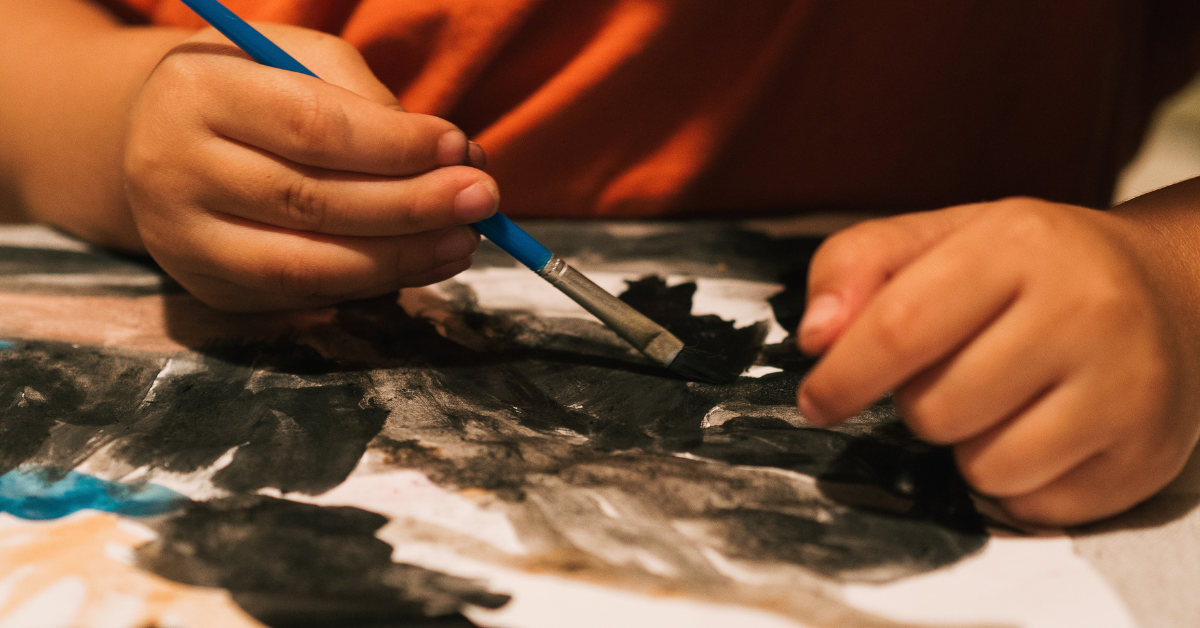
Think back to your own education, about a time that arts-at-school made a lasting impression on you. Perhaps it was wrapping squares of tissue paper around our pencil erasers to create a unique Mother’s Day card. Maybe we contributed to a mural on the elementary playground, or played a role in the middle school musical, or kicked off homecoming as a member of the marching band.
Whatever our arts involvement looked like, the payoff was probably greater than we realized at the time. This shouldn’t come as a surprise. Time and time again, research points to arts education as a major contributor to students’ overall academic and social achievement.
It has been linked to lower drop-out rates, higher academic recognition, and even “as a way to close the gap between low-income and high-income schools.” (LaRuffa, 2019). Now, thanks to new studies by the National Endowment for the Arts and Houston University, art in schools has been tied to improved social-emotional outcomes, too.
How Do SEL and the Arts Overlap?
It turns out, there’s a pretty seamless integration between the arts and social-emotional learning (SEL). Most art instructors will say that it’s always been this way. But the more recent lens on SEL has given us the language to name these points of intersection. Let’s explain.
Social-emotional learning is a set of tools that enable young people to set and achieve goals, self-manage behaviors, develop and maintain healthy relationships, and work collaboratively with others. SEL processes are demonstrated through five core competencies: Self-Awareness, Self-Management, Social Awareness, Responsible Decision Making, Relationship Skills.
Artistic processes, meanwhile, “are the cognitive and physical actions by which arts learning and making are realized.” (National Arts Standards). And, like SEL, artistic expression is also demonstrated through a set of processes: Creating, Performing, Responding, and Connecting. (These four indicators are also the way the most districts go about evaluating student performance in the arts).
Thanks to the work of ArtsEdSEL and University of Chicago’s Consortium on Research, we can now view these two seemingly separate entities- SEL and Arts Education- as a crosswalk (or matrix) of overlapping, mutually supportive skill sets.
What Does This Look Like In Practice?
Let’s explore, as one example, the indicator of creativity- an artistic process with plenty of cross-over value. Megan Fitzgerald of Tinkergarten argues that creativity is just as important as literacy. “It’s hard to overstate the importance of creativity,” she says. “Creative thinking is a critical skill; not only for artists or musicians, but also for kids as a way of thinking about- and being in- the world.”
Fitzgerald’s thinking checks out. The World Economic Forum’s Future of Jobs Report names creativity (alongside complex problem solving and critical thinking) as one of the “three most important skills a child will need to thrive.” Not to mention, 72% of business leaders say that creativity is the top skill that they seek when hiring. (Arts Education Navigator).
Creative exploration through art speaks to elements of self-awareness, like recognizing one’s own thoughts, feelings, strengths, and limitations. It can teach learners to handle daily tasks and challenges (self-management) and to persevere through set-backs (social-awareness).
Meanwhile, as students consider the thoughts, feelings and artistic inspirations of other artists, they are flexing their relationship skills muscles. And responsible decision-making is encouraged when students explain their own artistic intent or when they work in groups to achieve a larger scale project.
Where Do We Go From Here?
Many arts-at-school initiatives naturally embed these and other SEL intersections. Mindfully spotting and naming them is something that many of us are new to. But with practice, we can grow in this area.
Take, for example, the Art Docent Program, a school-based initiative that blends art history and art skills education. The classes are taught by “docents”- parents or staff who are guided by the Art Docent Curriculum. Students take part in an interactive Gallery Walk followed by a studio session. The combination of these two arts experiences (considering other artists’ perspectives and then diving into their own creative zone) allows students to strengthen skill sets across the five SEL competencies.
Opportunities to interpret and evaluate artistic works can open doors for students to consider diverse viewpoints and cultural experiences. Then, in creating their own works, learners must identify their own message, set personal goals, determine appropriate strategies, and share class tools and supplies. Each of these skills represents a SEL synergy.
Creative art can help kids flourish in virtually all areas of development. “Through creative art, children may be able to represent experiences that they cannot verbalize,” says the Extension Alliance for Better Child Care. “They may draw pictures out of proportion, exaggerating things that are important to them.”
The Alliance concludes: “When we value children’s creativity, we help them feel valued as people, raising their self-esteem. When children work together in the art area, they learn to share, to interact with others, to be responsible for cleanup, and to put materials away. These are positive and important changes for social learning.”
We already know the incredible role that arts play in a child’s education. Now we have another reason to fight for students’ access to arts programming: Their social and emotional wellbeing is better for it.

